News
The Active Healthy Kids Global Alliance has released a report examining physical activity among children in 49 countries, with Slovenia, Japan and Zimbabwe having the most active youngsters. However, while the story is a good one in these three nations, the overall trends in other countries indicate that most children are not getting enough activity to ensure health growth and development.

Part of the press kit. www.activehealthykids.org
The study claims that the high levels of physical activity among Slovenian children are related to the central role that sport plays in the national identity, as well as the fact that the fitness of all children aged 6 to 19 is measured each year using a standardised test. Slovenia thus obtained a top grade of A- for overall physical activity, a B+ for family and peers and an A for government, which assesses the strategy and resources applied by the state to ensure more active lifestyles.
With regard to Japan, the report notes that the country “has a highly established ‘walking to school practice’ that has been implemented since the School Education Act enforcement order, enacted in 1953. It states that public elementary schools should be located within no more than 4 km, and for public junior high schools no more than 6 km from the student’s home.”
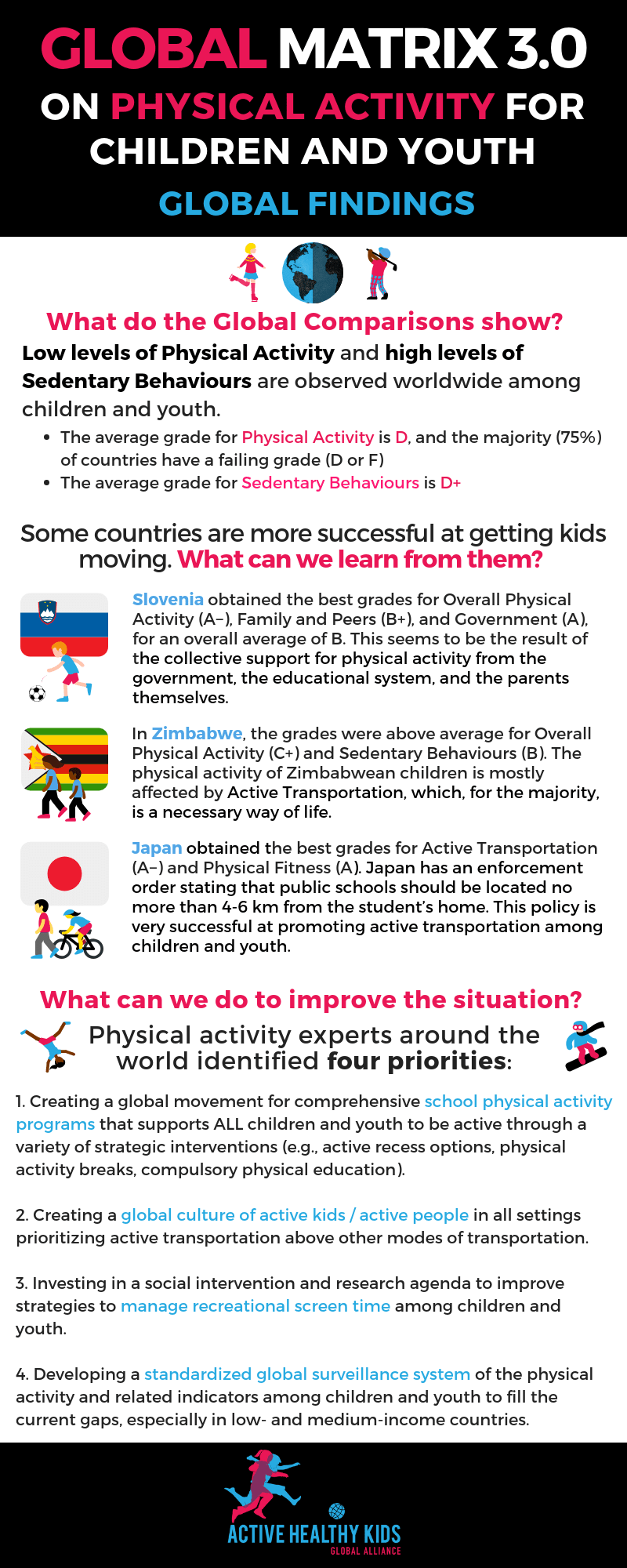
Part of the press kit. www.activehealthykids.org
It’s a similar story in Zimbabwe, albeit for different reasons, as “overall physical activity is mostly affected by active transportation which, for the majority of the children in Zimbabwe, is a necessity in everyday life.”
While Slovenia got an A- for “overall physical activity”, the United States got a C-, with the full report available here if you’d like to see where your country stands.
Although climate change seems to be moving the snowline ever higher, forcing many resorts to buy snow machines and push back opening dates, skiing in Slovenia remains a big part of the country’s seasonal tourist offer. And with the skiing, snowboarding, sledding and so on season about to begin, the newspaper Finance has put together an overview of what’s new at Slovenian ski resorts for 2018/19 season. Since this is in Slovene and behind a paywall we’ve put together the main points below, as the slopes get ready for their first customers in the next few weeks, weather permitting. On that point, note that the last day for pre-season discounts at most places is November 30, so act now if you want one of those.
RTC Krvavec is set to open on Friday, November 30, and for this year the centre has worked to increase skier safety, with more fences and other protective equipment, as well as enhance the resort’s entertainment programme. Looking to the future, Krvavec will add a wellness centre, swimming pool, glamping area and bungalows. Website
Related: Krvavec - skiing just outside of Ljubljana
Cerkno, now under the majority ownership of Postojna Cave, is aiming to open December 1, and this year visitors will see more activities on offer for children and families, as well as the resort now being a pet-friendly one. Website
Golte will officially open on December 8, and this year the centre has new apartments for guests to stay in. Website
Vogel, a rare mountain resort that sees more visitors in summer than winter, plans to open the slopes on December 15. The site’s capacity is up this year due to the new ski-lift that’s been installed, while further work is being done on the resort’s restaurants. Website
Maribor’s closest resort, Maribor Pohorje, is scheduled to open on December 14, and earlier if the weather brings snow. If not, the resort has invested in new snow cannons and snow-making equipment to keep the slopes white, and has also added a new toboggan run. Further improvements in the near future are a new chairlift system. Website
The season is expected to start on December 19 at Rogla, with this year’s innovations being the renovated Rogla Hotel, a covered conveyor belt, an a parking area with space for up to 40 motorhomes. Website
Kranjska Gora is also opening on December 19, and this season the resort will have new snow cannons and a new ski lift. Attempts to build a gondola to the top of Vitranc are still on hold until a building permit is obtained. Website
Related: Winter in Kranjska Gora
Kanin/Sella Nevea, the highest ski resort in Slovenia, and one that goes over into Italy, will open with the first major snowfall, and at the time of writing had already received around 60cm on the upper slopes. When the place does open, with skiers advised to check the website for news, there will be renovated cable cars to take people to the top. Website
STA, 26 November - The international research project Implant Files has revealed that most Slovenian hospitals have no digital records on implants they put in patients. There is also no proper system of informing the Agency for Medicinal Products and Medical Devices on implant-related complications.
The only hospital in Slovenia with detailed digital records on all implants used is the Orthopaedic Hospital of Valdoltra in Ankaran, while other hospitals mostly still have them only in the paper form, including the National Institute of Public Health.
The digitalisation of medical data at Valdoltra started in the late 1990s and the hospital started building its own implant registry in 2002. According to the data from the ZZZS health insurance fund, the hospital conducted almost a quarter of all hip implant operations and almost a third of all knee replacements in Slovenia last year.
Statistical data show that there were no complications during most of the hip and knee surgeries, said journalists Anuška Delić and Maja Čakarić of the Oštro centre for investigative journalism in the Adriatic region.
But Delić and Čakarić warn that in Slovenia data on complications involving implants are difficult to find, as the system of reporting to the Agency for Medicinal Products and Medical Devices does not seem to be working properly.
In the last three years, the agency was notified of 258 complications related to implants and only 10% of these reports came from medical institutions, which are obligated by law to report to the agency within 24 hours after any complications.
In a response to the report, the agency said it was aware of the risks for patients, adding that as the competent body it had supervisory mechanisms at its disposal for the protection of health of Slovenian and EU citizens.
Its inspectors are performing supervision over producers and retailers and wholesalers of medicinal products and are overseeing their use in hospitals, healthcare centres, retirement homes and other institutions providing medical care.
The pharmaceutical inspection so far has not established major departures from the standards which would suggest that medicinal products on the Slovenian market are ineffective or pose a risk for users, the agency added.
It noted that the relevant EU regulations would be updated and enter into force in 2020, with the main advantages being better quality, safety and reliability of medicinal products and better transparency of information for consumers.
According to unofficial information, doctors more frequently report about problems to the implant manufacturers, although reporting to them is voluntary.
Most medical implants in Slovenia come from four companies
Data on implants by Valdoltra, UKC Ljubljana, UKC Maribor and the general hospitals of Celje, Jesenice and Novo Mesto show that more than half of the implant market in Slovenia is controlled by four big manufacturers: Zimmer Biomet, Johnson&Johnson, Stryker and Lima, the newspaper Večer reports in today's spread on the topic.
The 250 journalists from 36 countries participating in the research project found that 1.7 million injuries and almost 83,000 deaths in the last decade could be linked to implant fractures, decay, bending or other malfunctions. For Slovenia no such data is available due to poor record-keeping.
A national registry of implants should, however, be set up by Valdoltra as of next year. The hospital's current detailed records show that on average some 12% of hip implants and some ten knee implants have to be replaced a year.
Once the registry is completed, the data on implants will be available in an on-line application. According to the National Institute of Public Health, the digitalisation and the forming of the registry would cost EUR 30,000 and just as much should be spent annually for updating and maintaining the registry.
But for the time being, Valdoltra expects no additional costs as its existing staff is expected to work on the project.
The Implants Files international project website can be found here
STA, 26 November 2018 - Education Minister Jernej Pikalo discussed how to prevent anti-Semitism at Monday's session of the EU's Education, Youth, Culture and Sport Council in Brussels, pointing to the thin line between freedom of speech and hate speech and noting that the educational system played the key role in preventing the spreading of hatred.
Pikalo said that all European societies had the problem of defining the line between freedom of speech and hate speech, which was why all kinds of deviations were taking place.
Related: Our stories on hate speech can be found here
The minister stressed that more proactivity in the prevention of spreading of hatred towards any individuals or groups would be introduced in the educational system.
"Policies and approaches in this field must be especially sensitive and proactive, because we must not allow any of the historical situations we were in to repeat," Pikalo stressed.
He said that the Holocaust must not be only a history lesson, but a lesson for the present time, adding that Slovenia was playing an active role in that respect.
Slovenia sends teachers to Israel each year
Pikalo noted that around 50 teachers from Slovenia went to Israel every year as part of an educational programme, adding that Slovenia also had curricular and extracurricular activities which promoted democratic awareness.
In the context of hate speech, the minister also commented for the press on the call by Prime Minister Marjan Šarec to state-owned companies to reconsider pulling ads in the media which instigate hate speech.
Related: Our stories on Jewish Slovenia are here
Pikalo said that he supported Šarec's call. "It does not matter at the moment what direction the matter will take," he said, noting that the prime minister was not calling on the companies to act, but to consider an idea.
The EU ministers also discussed youth-related topics, focusing on the question of how to best implement the new European strategy for youth.
Slovenia wants greater integration of EU education
Pikalo said that from now on, the sessions of the government council for youth will feature relevant ministers, who would get better acquainted with the problems and challenges faced by the youth sector in Slovenia.
The ministers further discussed the Towards a European Education Area by 2025 document, a new initiative recently unveiled by the European Commission, which includes the idea to establish a network of European universities.
As a country which wants to be at the core of the EU, Slovenia wants to be connected in the field of education, said Pikalo, while noting that educational policies were always national policies.
The minister said that he had received initiatives from two Slovenian universities for cooperation at the EU level, adding that his ministry supported such integration.
STA, 26 November 2018 - As Slovenia observes Days of Activism Against Gender-Based Violence, the country's Social Chamber drew attention to violence against people with disabilities, which they say remains a taboo topic.
Kvas called for a comprehensive approach to violence, warning that violence against persons with disabilities is a social problem affecting everyone. She urged those who observe such form of violence to report it and to help the victims.
Data from the two schemes that allow the disabled in wheelchairs or using braces to withdraw from a violent environment shows that violence against the disabled is more widespread than against the rest of the population, that women are more at risk and that violence is present within the family and in institutions.
Related: Domestic violence remains common in Slovenia
Breda Božnik, a state secretary at the Ministry of Labour, Family, Social Affairs and Equal Opportunities, said that violence against women was a universal phenomenon, a "tenacious and grave violation of human rights" and that disabled women were especially vulnerable.
Slovenia has a domestic violence prevention act, but the ministry is drawing up a resolution on the prevention of violence against women, which is to be passed next year.
Human Rights Ombudsman Vlasta Nussdorfer gets "a letter from a person drawing attention to violence every once in a while", but when her team tries to intervene many do not want help for fear that they would become even more isolated and would not benefit from trying to prove violence.
Nussdorfer said that this was not the right message to the perpetrators "so it's right that the media should draw attention to the unacceptability of violence against people with disabilities." She also called for raising awareness of the victims.
Related: Ljubljana by Wheelchair presents the most accessible places in the city
STA, 26 November 2018 - Port operator Luka Koper reported on Monday a nine-month net profit of EUR 49m, which is a 22% improvement on the same period last year. Net sales revenue was up 6% to EUR 168m.
Excluding the EUR 9.1m compensation received over damage to a bridge crane caused by a ship during a storm, the January - September 2018 net profit would amount to EUR 40.9m, a 3% year-on-year improvement, the company pointed out.
The group's operating profit (EBIT) rose by 29% to EUR 57m or by 8% to EUR 47.4m when discounting the mentioned one off event.
The core company recorded EUR 165.5m in revenue, a 7% increase, net profit rose by 22% to EUR 47.7m, EBIT by 30% to EUR 55.8m and EBITDA by 22% to EUR 77.2m.
Transshipment in the port was just under 18 million tonnes, which is on par with the first nine months of last year. March saw a monthly record of 2.3 million tonnes.
Luka Koper had a workforce of 1,217 at the end of September, a 11% increase on a year earlier.
It spent EUR 9.5m on investment at the level of the group.
All our stories on Luka Koper port are here
Below is a review of today’s news in Slovenia, summarised by the headlines in the daily newspapers for Tuesday, November 27, 2018, as prepared by the STA:
DELO
NASA mission on Mars
"New researcher from Earth on the red planet": NASA's Insight lander has sent the first photo of Mars only minutes after successfully landing on the red planet. (front page)
Student dormitories
"824 students without roof over their head": Although the Student Dormitory Ljubljana announced this summer that they have enough beds available for students, it turned out that 824 students were left without one. (front page, 8)
Russia-Ukraine incident
"Battle for the Sea of Azov": Only little more than a week after the EU's "foreign minister" Federica Mogherini announced new sanctions against Russia, a new armed clash between Russian and Ukrainian military vessels happened in the Sea of Azov. (front page, 6)
DNEVNIK
As-Primus
"Subcontractors left empty-handed": The company As-Primus, which owes subcontractors about EUR 1m, is being investigated by the National Bureau of Investigation (NBI). According to the paper's sources, the problems stem from a few years ago, while the NBI is focussing on last year's change in ownership. (front page, 4)
Local election
"Kamnik: Who will win in the duel of deputy mayors?": The second round of local election in Kamnik is expected to bring a neck-and-neck result for the two Kamnik deputy mayors, Mateja Slapar (NSi) and Igor Žavbi (LMŠ), who are close allies. (front page, 9)
Ukraine-Russia incident
"Ukraine-Russia: Ukraine declares martial law after incident in Kerch Strait": Ukrainian President Petro Poroshenko declared a 60-day period of martial law after Russia seized three Ukrainian navy ships in the Kerch Strait. (front page, 6, commentary 14)
FINANCE
Illegal construction
"Will you be able to legalise illegal building?": The paper brings a story about how a clerk can prevent an illegal building from being legalised if they are not convinced by the evidence in favour of legalisation. (front page, 2-3)
Oil prices
"Oil prices dropping. Will heating oil and fuel also get cheaper?": The oil prices rose by 3% after the Russian-Ukrainian conflict but they still remain 30% below the peak that was reached in October. (front page, 4-5)
Appointments
"Before appointment of AZN and BS heads: Why don't we have strong financial supervisors": We have been without a full-fledged central bank governor for more than 200 days and today the new head of the Agency for Insurance Supervision (AZN) is expected to be appointed, the paper says. (front page, 7)
VEČER
Migration
"In spotlight: Wire on the Kolpa, winter ahead": The new prime minister, Marjan Šarec, had been promising that he will strive for the wire on the Slovenian-Croatia border to be removed, but the panel fence on the Kolpa river is now being fitted with razor wire. (front page, 3)
PM's reaction to hate speech
"How to fight hate speech": Prime Minister Marjan Šarec raised dust with his clear view on how hate speech should be tackled. He said he was happy to have gotten people thinking about the issue. (front page, 2-3)
Crime
"Soldier gets 19 months": The court sentenced soldier Goran Ognjenović to 19 months in prison for causing a fatal accident but he received no punishment for fleeing the scene. (front page, 20-21)
STA, 25 November 2018 - A comic book about the life of author Ivan Cankar (1876-1918) has won the Book of the Year Grand Prix at the 34rd Slovenian Book Fair, which will conclude later today.
The biographic novel entitled Ivan Cankar: Podobe iz Življenja (Ivan Cankar: Images from Life) by Blaž Vurnik and Zoran Smiljanić marked the centenary of Cankar's death, observed this year.
"The precise, chronologically linear Vurnik's screenplay is supported by fragments from Cankar's works, letters and documents from his time. Skilfully zoomed in black-and-white images in Smiljanić's recognisable film language are dynamically intertwined with the self-conscious design and typographic attentiveness of Katja Kastelic," the jury said.
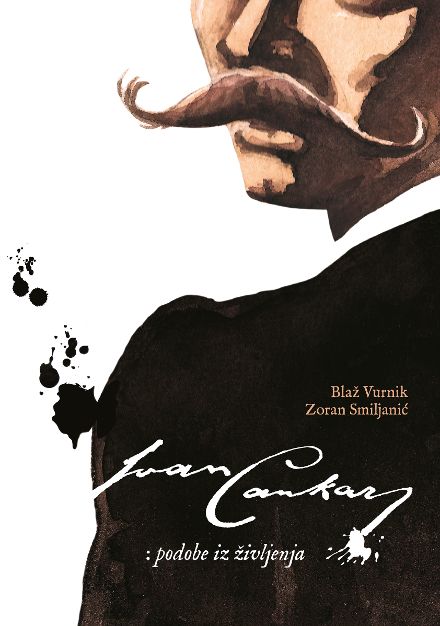
The cover of the winning book, available in stores and online from Stripburger
The comic book translates an intense life story, full of twists and turns and fatal decisions, into a "superb reading experience", according to the jury.
The authors of the comprehensive publishing project have created a work that will be also topical beyond 2018, Cankar's year. "They have created a character of the biggest Slovenian writer that we have not known before", the jury said.
A hundred years after his death, Cankar has become an immortal comic book hero thanks to the book issued by the Ljubljana Museums and Galleries and Forum Ljubljana as a special issue of Stripburger, a comics magazine, it added.
The five-member jury assessed books that were issued between 1 October 2017 and 1 October 2018 based on their contents, editing, language, design, illustrations, photographs and graphics.
Four other books were shortlisted for the prize
Next to the winning book, four other books were shortlisted for the prize: Žiga Valetič's review of the Slovenian pop-rock in the 1980s, Novi Maribor (New Maribor) by Primož Premrzl, Anja Štefan with her collection of poems for children whose title translates as Crumbs from Mouse Valley, which already earned her this year's Večernica prize, and a book about Aleš Debeljak's postcards by Erica Johnson Debeljak and Nela Malečkar.
Last year, the Book of the Year Grand Prix went to Vrata Nepovrata (The Door of No Return), an epic poem which took Boris A. Novak 20 years to write.
The Slovenian Book Fair, the biggest publishing event in the country, started on Tuesday evening featuring 106 exhibitors and more than 300 events. The organisers estimated the number of visitors at some 30,000.
The fair, which paid homage to Cankar this year, will close this evening with a debate featuring Croatian author Slobodan Šnajder and playwright Dušan Jovanović.
STA, 26 November 2018 - The latest poll released by Delo indicates the government is becoming increasingly popular, but this has not helped the ruling Marjan Šarec List (LMŠ), which has lost ground to their coalition partners, the Social Democrats (SD). The opposition Democrats (SDS) remain by far the strongest party.
The government's approval rating improved from 2.52 to 2.76 on a 1-5 scale, shows the Mediana poll carried by Delo on Monday.
In the party rankings, the SDS has retained the top position, although it lost some ground. It polled at 18.3%, a drop of more 0.3 points.
The SD gained ground, apparently mostly at the expense of the LMŠ.
It mustered 8.9%, almost two points higher than in October, while the LMŠ saw the reverse trend, going from 8.9% to 7%.
In the ranks of the opposition, the Left remained flat at 6.1%, New Slovenia (NSi) added 0.6 points to 5.5% and the National Party (SNS) was also up 0.6 points to 3.8%.
Related: Our guides to most of Slovenia’s political parties are here
Among the coalition parties, the Modern Centre Party (SMC) and Alenka Bratušek Party (SAB) lost ground, polling at 3.7% and 3.2%, respectively, while the Pensioners' Party (DeSUS) was up over a point to 3.4%.
Buoyed by a solid result in the local election, the non-parliamentary People's Party (SLS) went from 1.7% to 3.8%.
Pahor the most popular figure in Slovenian politics, but Janković also rises
In the politicians' popularity rankings, President Borut Pahor remains in the top position with a grade of 3.57 on a 1-5 scale, while Prime Minister Marjan Šarec made the jump from fourth to second, his ranking going from 2.89 to 3.18.
EU Commissioner Violeta Bulc and MEP Tanja Fajon, who have for years been trading places in runner-up position, have been pushed to third and fourth place, respectively.
SDS lawmaker Anže Logar, who failed to beat incumbent Mayor Zoran Janković in the recent local election but managed the best result so far for a centre-right candidate, is in fifth place, but Janković, in seventh, made the biggest jump of all the politicians in the top 20.
The poll was carried out by Mediana between 13 and 22 November and involved 714 respondents.
STA, 25 November 2018 - The Kidričevo-based group Talum, which is increasingly adding production of ready-made products to the principal activity of aluminium production, expects good business results this year despite the turbulent and unpredictable situation on the global market, chairman Marko Drobnič has told the STA.
According to him, the conditions in the aluminium industry globally have been extremely dynamic and unpredictable this year, both in terms of supply of raw materials as well as their prices.
He said the situation had never been this tough before.
Drobnič attributed this to the relations between the US, Russia and China, most notably the US's sanctions against certain Russian companies, its introduction of customs, and environmental restriction on production in China.
A focus on greater added value
Talum had to respond quickly to the growing prices of the raw materials used in the production of primary aluminium, especially aluminium oxide.
Since the production of aluminium in Europe will become a relatively sensitive matter given the circumstance, Talum's strategic goal since 2012 has been to raise the value added of its products.
The new business strategy for 2018-2022 also follows this guideline. According to Drobnič, the emphasis will be on sustainable development, renovation and optimisation of business processes and digitalisation.
"I see great potential for development in innovation. A key priority is also to train staff to be able to respond to changes, given the developments outside that are extremely dynamic and unpredictable," the CEO said.
Talum expects revenue to reach some EUR 360m at the end of the year, which is 3% more than in 2017. Profit is expected to be somewhat lower, at EUR 1.5m.
The group currently employs 1,500 people, which is 125 more than at the end of 2017.
The company's Engish website is here
The lights get turned on in Ljubljana at 17:15, Friday November 30 (2018), and in recent years an increasingly popular place to see this happen is not where the switch is flicked – the still busy Prešeren Square, by the tree – but instead up at the Castle, where you can get a bird’s eye view of the action and then go down and experience it close up, two ways to see the city in one trip.
But it’s not just views of the city that Ljubljana’s top attraction offers during advent, as the place also has seasonal activities of its own in addition to all the usual ways to enjoy it (as laid out, for example, in Ten Ways to Enjoy Ljubljana Castle).
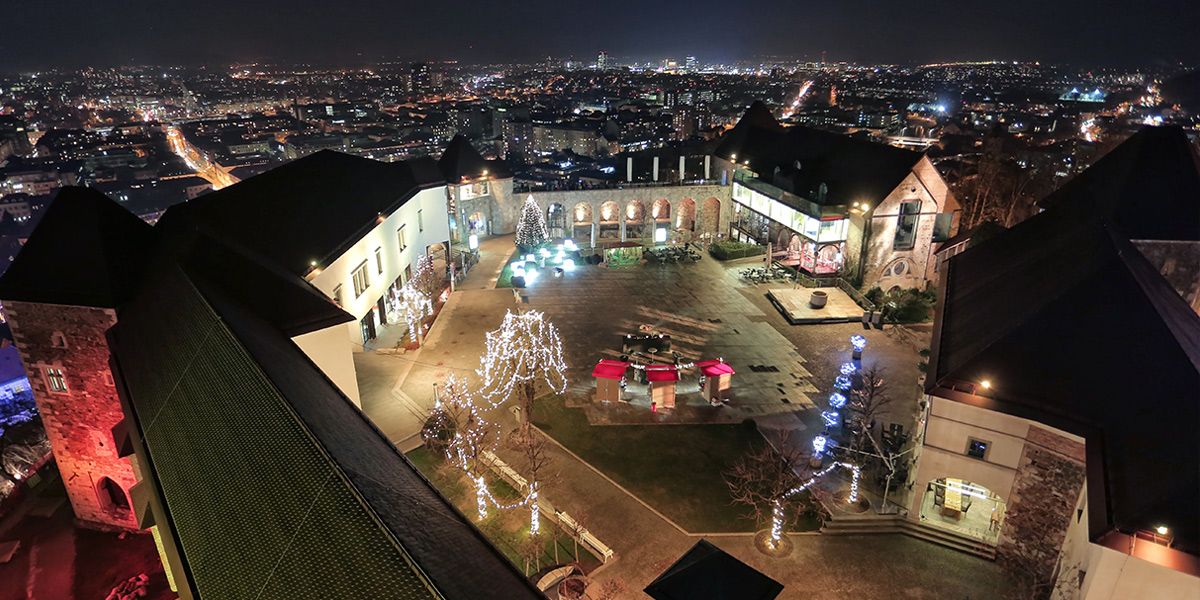
The courtyard from the Viewing Tower in an earlier year. Photo: Miha Mally, www.ljubljanskigrad.si
This Friday thus also marks the start of the festive fair in the Castle courtyard, which will have decorations and stalls selling seasonal food and drinks, including mulled wine in case you forgot to bring gloves. The same day will also see the display of life-size wooden sculptures making up a Nativity Scene, which can be visited until January 6 in the Lower Lapidarium.
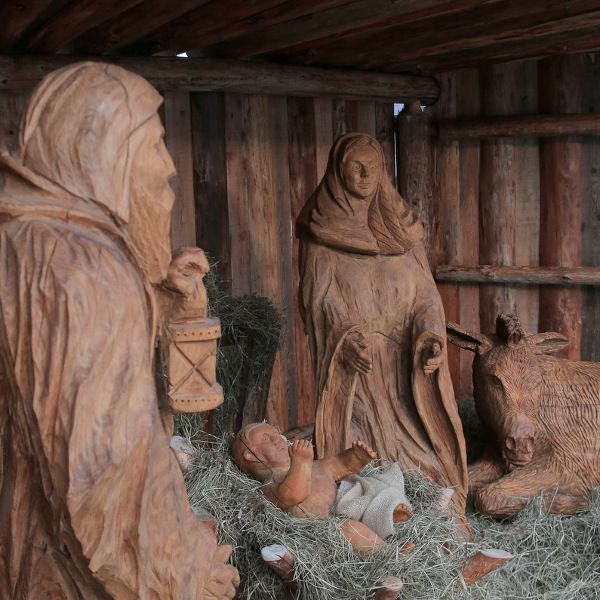
Photo: Miha Mally, www.ljubljanskigrad.si
Starting a week later, on December 5, is a new exhibition in the Pentagonal Tower, the original entrance to the Castle. This appeals to the Christmas message of helping the poor, sick and unloved, and will give you the chance to adopt a UNICEF rag doll. For a donation of €20.00 UNICEF is able to vaccinate one child against six contagious diseases, while you’re able to take home a charming doll for yourself or as a gift.
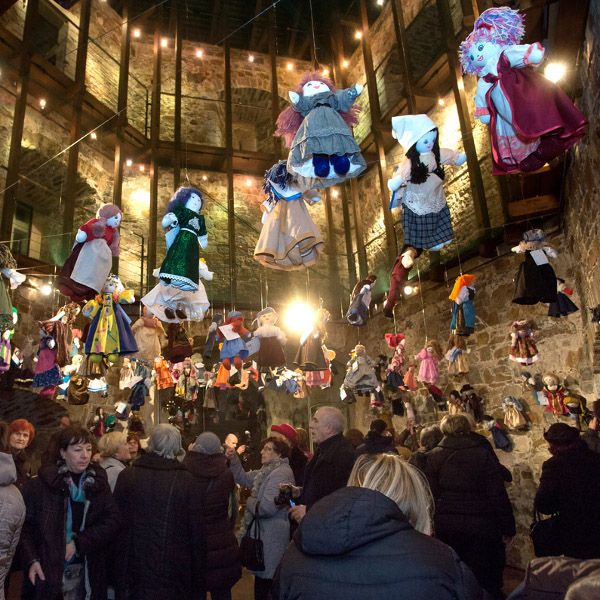
The dolls in the Pentagonal Tower. Photo: Nada Žgank, www.ljubljanskigrad.si
A little closer to the big day is Awaken the Dragon, a free architectural projection and 3D mapping experience that will bring to life the story of the Ljubljana Dragon. This is a new attraction at the Castle, and can be seen every day, from 21 December 2018 to 2 January 2019, between 17:00 and 20:00.
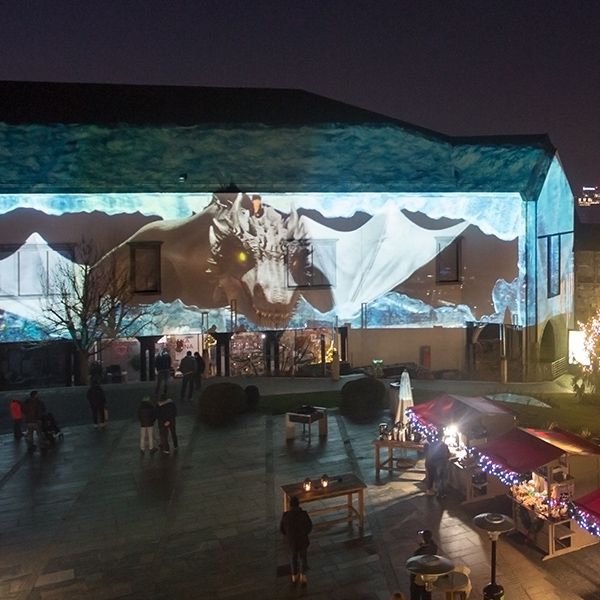
Awaken the Dragon will use the Castle as a projection screen. Photo: Miha Mally, www.ljubljanskigrad.si
On December 22, a Saturday, there’s Festive Dancing at the Castle from 20:00 on, with Latin American and festive music. Tickets include a ride up and down on the funicular, and entrance to the viewing tower, with more details here.
The Christmas events come to a peak on December 24, when you can visit the Chapel of St George for Christmas Holy Mass, starting at 22:00, with the service enhanced by festive songs performed by the Choir Megaron. However, note that this chapel is a small one, and seating will be rather limited if a crowd turns up.
The month and year then end on December 31, when the fireworks that light up at the sky at midnight will be taking off from the Castle, encouraging oohs and ahs from the crowds in the city who have come out to enjoy the various concerts in squares around town.
In addition to these seasonal events the Castle continues with it’s regular Friday night jazz concerts, with the schedule here and more details, including video, found by clicking the artist’s name. There’s also more on dragons, those from Ljubljana and elsewhere, with the exhibition The Dragon of All Dragons continuing until January 6 2019. In short, while a trip to the Castle is rewarding anytime you’re in the city, in the last month of the year there’s even more to see and do at the top of the hill that watches over Ljubljana, when it’s open from 10:00 to 22:00. And if you're in town and want some other things to do, beyond the Castle, then check out our latest What's on guide... here





